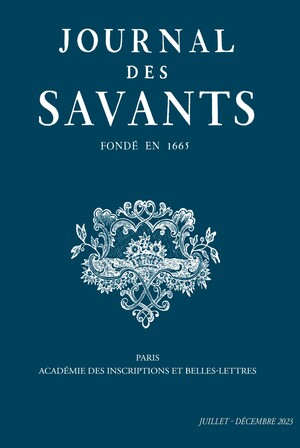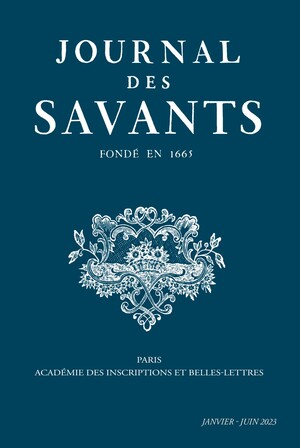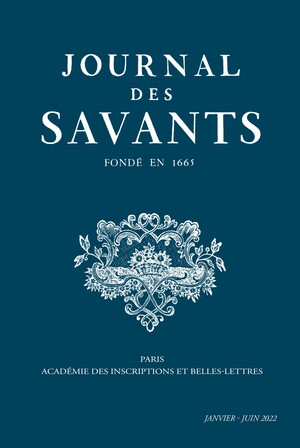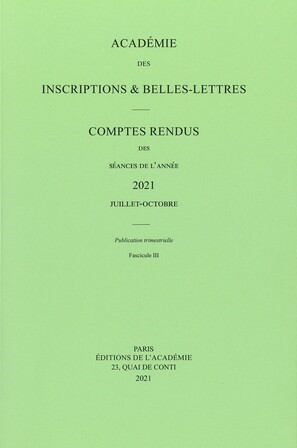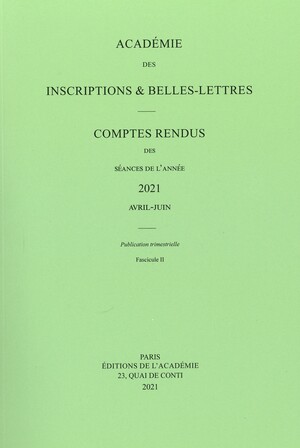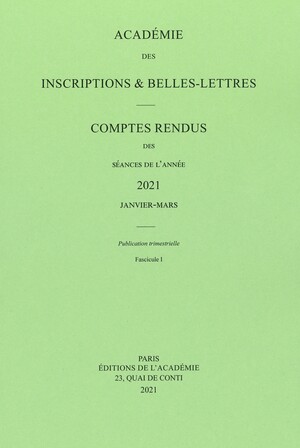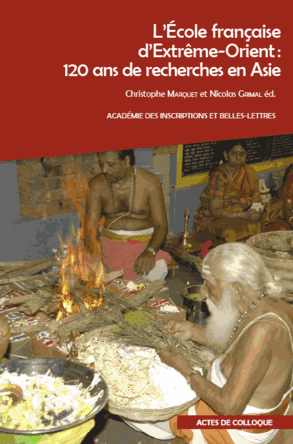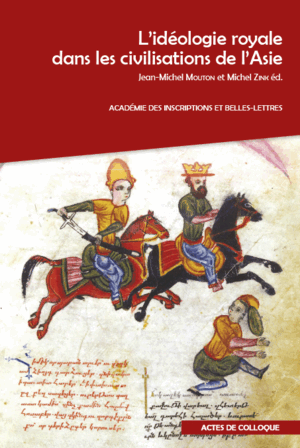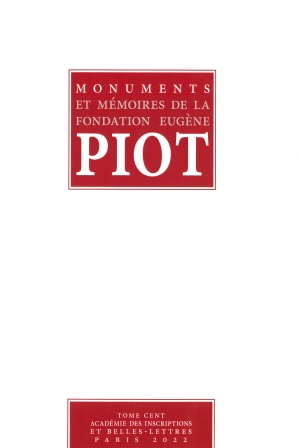Publications Archivum Latinitatis Medii Aevi 75, 2017
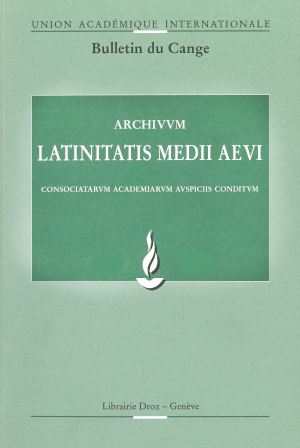
Archivum Latinitatis Medii Aevi, n° 75
Date : 2017
391 pages.
Pour se procurer ces périodiques :
Librairie Droz, 11 rue Massot Case Postale 389
1211 Genève 12 – Suisse
Tél : +41 22 346 66 66 ; Fax : +41 22 347 23 91
Site : www.droz.org
Courriel : droz@droz.org
Présentation
I. ARTICLESCODOÑER C., De nuevo las palabras en Isidoro de Sevilla : p. 21-57
RÉSUMEN. – El léxico isidoriano de la Etymologías ha sido objeto de numerosos estudios, especialmente en lo que concierne a la terminología que va introducida mediante dicitur, dicunt, dicimus, adverbios como uulgo, olim, los sustantivos uulgus, antiqui, pronombres o adjetivos de primera persona plural : nos, noster, etc. Este artículo analiza un número de palabras así caracterizadas, con el fin de precisar si la presencia de estos elementos responde a la realidad que parecen determinar o si, antes de aceptar su validez, deben ser sometidos a un análisis en profundidad.
ABSTRACT. – The Isidorian lexicon of the Etymologies has been object of numerous studies, especially as regards the terminology that is introduced by means of dicitur, dicunt, dicimus, adverbs like uulgo, olim, the nouns uulgus, antiqui, pronouns or adjectives of the first person: nos, noster, etc. This article analyzes a number of words so characterized, in order to determine if the presence of these elements responds to the reality they seem to determine or if, before accepting their validity, they should be subjected to an in-depth analysis.
SPEVAK O., Les additions dans Isid. Etym. I : témoins d’un travail rédactionnel : p. 59-88
RESUMÉ . – Le livre I des Etymologiae d’Isidore de Séville, intitulé De grammatica, contient un nombre considérable d’additions et de variantes textuelles d’ordre divers. Cela pose de grandes difficultés à celui qui prépare une édition critique de ce livre. D’un autre côté, les différences entre les manuscrits permettent de mieux cerner les rapports entre eux et entre leurs familles. Pour l’établissement du texte du livre I, il est nécessaire d’élaborer une méthode rigoureuse. Dans un premier temps, nous allons retenir les éléments caractéristiques pour chacune des trois familles des manuscrits. Dans un second temps, nous procéderons à l’évaluation des additions introduites dans la famille α (« famille française »). Pour ce faire, nous allons considérer plusieurs paramètres : non pas seulement l’addition elle-même, mais aussi sa source (s’il est possible de la préciser), sa justification dans le contexte ainsi que la présence d’autres additions dans le même manuscrit. Nous essayerons de montrer que les additions dans la famille α concernent surtout les manuscrits innovateurs qui présentent, en outre, des corrections du texte. Ces interventions ne sont pas imputables aux scribes mais aux rédacteurs qui ont préparé le texte pour la copie.
ABSTRACT. — Book I of Isidore of Seville’s Etymologiae, entitled De grammatica, contains a considerable number of additions and textual variants. On the one hand, this poses many difficulties to the editor preparing a critical edition of the text; on the other hand, differences between manuscripts help identifying the relationships between manu- scripts and between the families of manuscripts. For establishing of the critical text, it is necessary to develop a rigorous method. I will first identify the elements that are characteristic of each of the three families of the manuscripts. Then, I will evaluate the additions introduced into family α (the ‘French family’). In order to do so, I will take into consideration several parameters: not only the addition itself, but also its source (if it can be determined), its justification in the context, and the presence of other additions in the same manuscript. I will try to show that the additions in the α family mainly concern ‘innovative’ manuscripts that also contain various corrections of the text. The additions and corrections represent both interventions in the text that cannot be attributed to the scribes but are the work of the editors who prepared the text for copying.
IBAÑEZ CHACON Á., Interpolaciones de origen glosográfico en el Liber monstrorum : p. 89-106
RESUMEN. — Algunos manuscritos del Liber monstrorum contienen capítulos inter- polados que pueden tener un origen glosográfico, dado que presentan las características textuales de glosas y escolios y, además, completan el sentido de los breves relatos. Puede, por tanto, que el bestiario insular llegara al continente ya anotado y que poste- riormente algunas glosas acabaran incorporadas al texto.
ABSTRACT. – Some manuscripts of the Liber monstrorum contain interpolated chapters that may have a glossarial origin, because present the textual characteristics of glosses and scholia and, in addition, complete the meaning of the brief narratives. It can therefore be that the insular bestiary arrived to the continent already annotated and that later some glosses were incorporated into the text.
DUPLESSIS F., Les « proto-accessus » carolingiens sur Juvénal : formation et diffusion : p. 107-148
RÉSUMÉ. — Dans les manuscrits de Juvénal copiés entre la fin du IXe siècle et la fin du XIe siècle, les Satires sont fréquemment accompagnées d’un ensemble introductif formé d’une ou de plusieurs vies de Juvénal et de quelques scholies (pouvant porter sur les termes « Decimus », « Iunius », « Satyra », « Histrio », « Tragoedia », « Comoedia »). La première partie de cet article étudie la composition et les variantes textuelles de ces proto-accessus carolingiens sur Juvénal et met en lumière l’existence de trois grandes familles. La seconde partie est consacrée à l’étude de la diffusion et des sources de ces proto-accessus. Elle replace l’apparition de ces trois familles d’accessus au sein de l’histoire de la réception médiévale de Juvénal en soulignant l’importance du rôle joué par Heiric d’Auxerre et son disciple Remi d’Auxerre dans la constitution de ces proto-accessus. En annexe, sont édités à partir de dix-huit témoins les trois proto-accessus sur Juvénal, les gloses sur les Vitae Iuuenalis et les variantes significatives des Vitae Iuuenalis présentes dans ces accessus.
ABSTRACT. — In the manuscripts of Juvenal written between the late ninth century and the late eleventh century, we frequently find, before or after the Satires, an introductory set consisting of one or more lives of Juvenal and some scholia (which may include the terms «Decimus», «Iunius», «Satyra», «Histrio», «Tragoedia», «Comoedia»). The first part of this article studies the composition and textual variations of these Carolingian proto-accessus on Juvenal and highlights the existence of three major families. The second part is devoted to the study of the diffusion and sources of these proto-accessus. It places the appearance of these three accessus families within the history of the medieval reception of Juvenal by underlining the importance of the role played by Heiric of Auxerre and his disciple Remi of Auxerre in the creation of these proto-accessus. In appendix, the three proto-accessus on Juvenal, the glosses on Vitae Iuuenalis and the significant variants of Vitae Iuuenalis present in these accessus are published from eighteen witnesses.
SANTAMARIA HERNANDEZ M.T., Una acepción medieval de uermis en Medicina humana y veterinaria a partir del morbus farciminosus tardo-antiguo : p. 149-186
RESUMEN. — Este artículo está centrado en el análisis de una acepción médica y veterinaria del término uermis en escritos medievales sobre Medicina humana y equina. El término aparece en obras bajomedievales de Hipiátrica. Pero presentamos también algunos testimonios de manuscritos altomedievales que ofrecen este uso de uermis, pero que no han sido tenidos en cuenta hasta ahora en los estudios sobre el latín médico y veterinario. Para determinar la acepción de uermis en todos estos textos, se comparan con algunos capítulos de los tratados latinos tardoantiguos sobre Veterinaria y con algunos otros textos griegos.
ABSTRACT. – This article focuses on the analysis of a medical and veterinary meaning of the term uermis in mediaeval writings on equine and human Medicine. The term appears in late mediaeval works on Hippiatrics. But we also provide some testimonies of early mediaeval manuscripts offering these use of uermis, which have not been taken into account so far in the studies on medical and veterinary Latin. In order to determine the meaning of uermis in all these texts, we compare them with several chapters of the late antique Latin treatises on Veterinary and with some others Greek texts.
RÉSUMÉ. – Cet article analyse une acception médicale et vétérinaire du terme uermis dans des écrits médiévaux sur la médecine humaine et équine. Le terme apparaît dans des œuvres hippiatriques du Bas Moyen Âge. Mais nous présentons aussi quelques témoins de manuscrits du Haut Moyen Âge qui offrent cette acception de uermis, mais qui n’ont pas été pris en compte jusqu’à présent dans les études de latin médical et vétérinaire. Pour préciser le sens de uermis dans tous ces textes, on les compare avec quelques chapitres des traités latins de l’Antiquité tardive sur la médecine vétérinaire et avec quelques autres textes grecs.
BIONDI L., Espressioni metaforiche e deriuatio nei grammatici medievali: prime annotazioni : p. 187-216
RIASSUNTO. — Il contributo intende indagare le espressioni linguistiche di alcune metafore concettuali relative all’àmbito delle res naturae, elaborate dalla tradizione grammaticale antica per categorizzare ed interpretare il linguaggio e le sue strutture. Il contributo prende in esame in particolare una metafora relativa al dominio delle acque, giunta ai grammatici medioevali dalla Latinità e applicata alla nozione metalinguistica di deriuatio. Il ricorso estensivo a questa metafora nei testi grammaticali mediolatini rivela lo sforzo compiuto dai magistri nel rinnovare e risemantizzare le sue motivazioni originarie e corrisponde al crescente interesse nei confronti sia di una più precisa classificazione della deriuatio e dei suoi modi in quanto dimensione linguistica autonoma, sia di una più sottile delimitazione del suo statuto epistemico in rapporto a pratiche linguistiche, formali e speculative, quali etymologia, expositio, interpretatio.
ABSTRACT. – This paper aims to focus on linguistic expressions of some conceptual metaphors concerning the field of res naturae, that Ancient grammatical thought elaborated in order to categorize and to explain language and its structures. The paper deals in particular with a metaphor belonging to the domain of water, received by Mediaeval grammarians from their Latin ancestors and applied to the metalinguistic notion of deriuatio. The quite extensive use of this metaphor in Mediaeval grammatical treatises reveals an effort of the magistri to a renewal and a resemantization of its original motivations. This effort corresponds to the growing interest either to a more precise classification of deriuatio and its modi as an autonomous dimension, or to a more sharp definition of its epistemical status in comparison with other linguistic practices, such as etymologia, expositio, interpretatio.
RÉSUMÉ. – Cette contribution veut examiner les expressions linguistiques de quelques métaphores conceptuelles concernant les res naturae, élaborées par la tradition grammaticale ancienne dans le but de catégoriser et d’interpréter le langage et ses structures. En particulier, l’article analyse une métaphore qui concerne le domaine des eaux, reçue du monde latin par les grammatici du Moyen Âge et appliquée à la notion métalinguistique de la deriuatio. L’emploi extensif de cette métaphore dans la textualité grammaticale médiévale montre l’effort des magistri pour renouveler et resémantiser les motivations originaires ; il correspond à l’intérêt soit pour classer plus nettement la deriuatio et ses modi en tant que dimension linguistique autonome, soit pour délimiter plus précisément son statut épistémique par rapport à d’autres procédés linguistiques tels que etymologia, expositio, interpretatio.
CHRONOPOULOS T., The debate between Hebe and Ganymede in light of its sources and manuscript context : p. 217-244
ABSTRACT. —This article examines the anonymous twelfth-century debate poem between Hebe and Ganymede preserved in a unique manuscript, Munich, BSB, lat. 17212. I focus on the sources used by the author, who brought together all poetic treatments of Ganymede in Latin hexameter up until the 12th century: their chronological and geographical aspects provide a terminus post quem of 1184, the date when Alan of Lille is said to have finished the Anticlaudianus. Many of the contemporary sources have a Northern French flavour (e.g. Walter of Châtillon, Alan of Lille, Peter of Riga), while adjacent material in the manuscript also points to Northern France as the author’s likely provenance. I propose that the poem, given its limited circulation, unfinished nature, and forced rhetorical flourishes, is an exercise in style. In the appendix I provide a new edition and a new English translation.
RÉSUMÉ. — Cet article examine un débat poétique anonyme du XIIe siècle entre Hébé et Ganymède, conservé dans un seul manuscrit, Munich, BSB, lat. 17212. Je me concentre sur les sources utilisées par l’auteur, qui a rassemblé tous les textes poétiques traitant de Ganymède en hexamètres latins jusqu’au XIIe siècle: leur chronologie et leur géographie fournissent un terminus post quem de 1184, date à laquelle on considère qu’Alain de Lille a fini l’Anticlaudianus. La plupart des sources contemporaines évoquent la France du Nord (par exemple Guillaume de Châtillon, Alain de Lille, Pierre Riga), et le matériel voisin dans le manuscrit suggère aussi que l’auteur est originaire de la France du Nord. Je suggère que le poème, vu sa circulation limitée, son état inachevé, et ses ornements forcés, est un exercice de style. Dans l’appendice, j’offre une nouvelle édition et une nouvelle traduction anglaise.
PENSADO FIGUEIRAS J., El glosario Flor de las yervas (BNE-3338). Estudio y edición crítica : p. 245-374
RESUMEN. — La Flor de las yervas provechosas a la salud es un glosario inédito formado por lemas médico-botánicos con sinónimos y equivalentes terminológicos en distintos idiomas. Aunque la selección de voces en los glosarios de esta naturaleza responde a criterios oscuros para el investigador actual, el objetivo último de su composición era el de facilitar la comprensión del léxico empleado habitualmente en los tratados y de facilitar la práctica médica, evitando confusiones de orden lexicográfico, de graves consecuencias para los usuarios de la medicina. La Flor de las yervas se apoya en obras previas de naturaleza semejante: el más relevante es el glosario latino conocido por Alphita, compuesto a su vez a partir de otros glosarios de la alta Edad Media. También presenta concomitancias significativas con la Sinonima de los nombres de las medeçinas, que toma parte de sus lemas de la tradición árabe, concretada en los índices a la traducción latina del Canon de Avicena. Con tales fuentes, la Flor de las yervas constituye una importante muestra de la transmisión y la interpretación del léxico médico en su paso del latín y el árabe al romance medieval. Su análisis permitirá comprender mejor su composición y los elementos clave de su estructura, esenciales para abordar posteriormente una edición crítica que permitirá el acceso de la Flor de las yervas al público interesado.
ABSTRACT. — Flor de las yervas provechosas a la salud is an unpublished glossary made up of botanical / medical headwords with synonyms and equivalent terms in different languages. Although the selection of words in this type of glossaries responds to criteria unclear for the current researcher, its ultimate purpose is to facilitate the understanding of the lexicon commonly used in treatises as well as to facilitate medical practice, avoiding confusions of lexicographical order, which may have serious consequences for medicine users. Flor de las yervas is based on previous works of a similar nature: the most relevant of them being the Latin glossary known as Alphita, based, in turn, on other glossaries from the High Middle Ages. It also bears significant relation to Sinonima de los nombres de las medeçinas, which takes some of its headwords from the Arab tradition, specified in the indexes to the Latin translation of Canon de Avicena. With such sources, Flor de las yervas constitutes an important example of the transmis- sion and interpretation of the medical lexicon in its passage from Latin and Arabic to Medieval Romance. Its analysis will make it possible to better understand the way it was developed and the key elements of its structure, which is essential so as to later approach a critical edition that will allow those interested to access Flor de las yervas.
II. NOTES
LAJOYE P., Marisuppa. Un nom antique et médiéval du marsouin sur la façade atlantique française : p. 375-384
RÉSUMÉ. — Le mot *marisuppa ou *marisupa, attesté par divers textes latins de la fin de l’Antiquité et du Moyen Âge, et correspondant au français dialectal marsouppe, désigne le marsouin. Le sens de « truie de mer » est alors proposé.
Mots-clés : marsouin, cétacé, vocabulaire maritime, Bretagne, France.
ABSTRACT. —The word *marisuppa or *marisupa, attested by various Latin texts from the late Antiquity and the Middle Ages, and corresponding to the French dialectal marsouppe, refers to the porpoise. The meaning of « sea sow » is then proposed.
Keywords : porpoise, cetacean, maritime vocabulary, Brittany, France.
BRIX A., About two Couplets in Robert Gaguin’s Compendium : p. 385-391
ABSTRACT. —This paper aims at providing a source for two Latin distiches about the time of King Saint Louis that French humanist and historian Robert Gaguin reported in his Compendium de origine et gestis et Francorum (1495-1500). Two separate trails are hence followed through historiographical texts of the 13th and 14th centuries, until a manuscript is reached wherein the two couplets are preserved together (Paris, BnF, lat. 4892). Gaguin is likely to have used this volume from the abbey of Maillezais for his compilation.
RÉSUMÉ. —Cet article s’emploie à identifier la source de deux distiques latins relatifs à l’époque de saint Louis auxquels l’humaniste et historien français Robert Gaguin fait écho dans son Compendium de origine et gestis Francorum (1495-1500). Deux pistes indépendantes sont ainsi suivies à travers plusieurs ouvrages historiographiques des XIIIe et XIVe siècles, pistes qui se rejoignent en un manuscrit conservant ensemble les deux distiques (Paris, BnF, lat. 4892). Gaguin a probablement exploité ce volume issu de l’abbaye de Maillezais dans son travail de compilation.
I. ARTICLES
- SMIRAGLIA P., POLARA I., DE PRISCO A., Latinitatis italicae medii aevi lexicon. Addenda. Series altera. Fasc. 15: natalis-nympha
- CODOÑER C., De nuevo las palabras en Isidoro de Sevilla
- SPEVAK O., Les additions dans Isid. Etym. I : témoins d’un travail rédactionnel
- IBAÑEZ CHACON Á., Interpolaciones de origen glosográfico en el Liber monstrorum
- DUPLESSIS F., Les « proto-accessus » carolingiens sur Juvénal : formation et diffusion
- SANTAMARIA HERNANDEZ M.T., Una acepción medieval de uermis en Medicina humana y veterinaria a partir del morbus farciminosus tardo-antiguo
- BIONDI L., Espressioni metaforiche e deriuatio nei grammatici medievali: prime annotazioni
- CHRONOPOULOS T., The debate between Hebe and Ganymede in light of its sources and manuscript context
- PENSADO FIGUEIRAS J., El glosario Flor de las yervas (BNE-3338). Estudio y edición crítica
III. NOTES
- LAJOYE P., Marisuppa. Un nom antique et médiéval du marsouin sur la façade atlantique française
- BRIX A., About two Couplets in Robert Gaguin’s Compendium

